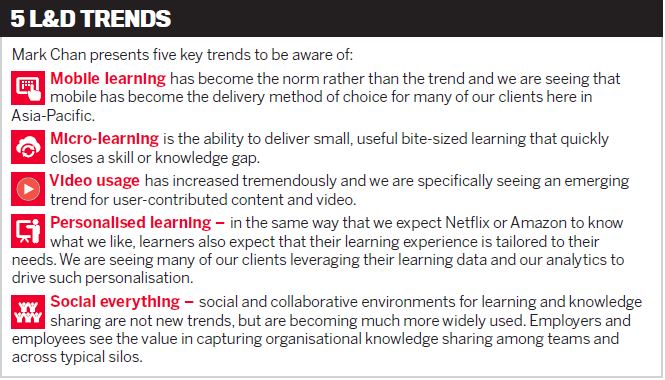All areas of HR are being disrupted, and L&D is no exception. What are the latest learning trends and how can HR create a culture of learning?

All areas of HR are being disrupted, and L&D is no exception. What are the latest learning trends and how can HR create a culture of learning?
Ask any HR professional and they’ll tell you just how essential L&D is to overall talent management. Indeed, Mark Chan, regional director of Cornerstone OnDemand, says that while effective talent management requires the smooth interlocking of key areas, including talent identification and recruitment, onboarding and career mapping, the linchpin is L&D.
“We believe that companies need to more effectively develop critical skills and competencies at all levels, to prepare employees for new positions and to develop future leaders,” he says. “In order to achieve this, employers must invest in L&D and training and put it at the core of their talent management strategy, creating a learning culture in their company.”
The key, Chan adds, is to provide learning programs that are aligned with employees’ career aspirations and development paths in order to provide career growth.
“People love to learn and this helps to keep them engaged. Sustaining a learning culture will support on-going knowledge exchange, which is particularly important to harness new emerging technologies in the workplace. The exchange of ideas and learning is also fundamental to enabling creativity and innovation.”
All change
As in other areas of HR, L&D is being impacted by various disruptive forces. For example, for the fi rst time in living memory, the workforce consists of fi ve generations working side by side. HR professionals must factor this reality into any L&D strategies.
“For training to be effective it is important to be able to support the different preferences refl ected in the demographics of your workforce,” says Chan. “Creating a learning culture to support the needs of different generations is just one part of a talent management plan to ensure a smooth transition as your workforce experiences a shift in generations.”
Chan says the ability and speed to adopt new learning technology naturally varies between age cohorts, so he urges employers to utilise different learning methods and content styles for both push and pull training.
For example, when providing a learning program for millennials, companies need to be aware that millennials are very likely to adopt a consumerised learning approach, which means that they proactively reach out to search content, but the consumption is fast and sometimes fragmented as they have a short attention span when viewing the content, and they usually do it on the go with mobile devices. Gamifi cation is another key element to consider blending into content design. Gamification content engages millennial learners in ways that static and formal content cannot achieve.
HR should also be mindful of accepting generational stereotypes.
“While we hear a lot about digital natives and millennials, it is the generation of baby boomers that has the expertise, experience and is often in positions of leadership,” Chan says. “Organisations can leverage these employees as valuable learning assets in their learning platform and get them to collaborate with other employees to share, exchange and regenerate skills and knowledge.”
By leveraging their learning platform, employers can also capture the knowledge and skills from their baby boomers. “The fact that millennials can do things faster than previous generations does not necessarily mean that they have the knowledge to do the right things,” Chan says.
Identifying and closing skills gaps
As the pace of change is so rapid in the business world, all employees must keep their skills sharp. Employers naturally play a key role in identifying and then closing these skill gaps.
For example, many organisations have well-established graduate recruitment and trainee programs to help fresh graduates transition from tertiary education to the commercial world. This has been the case in vocational and non-vocational areas.
“Traditionally, young adults were exposed to the world of work through after-school and vacation jobs,” Chan says. “However, with the increase in automation and these low-skilled roles being filled full-time, many young adults have not been exposed to these experiences and so may lack understanding of the basic work ethic. Therefore an organisation with a learning culture is attractive to them.”
When it comes to the transition of graduates into the business environment, employers need to develop programs that introduce new hires to the company culture, and offer focused, role-specific learning content.
“While an induction program may take a specific duration and time frame to accomplish, bridging skill gaps along an individual’s growth is an ongoing journey,” says Chan. “It also means companies need to develop talent at the speed of business change, and embrace the idea of lifelong learning.”
 Keeping track
Keeping track
Given there are so many components of talent management, how can HR keep track of the skills and competencies of their employees? Chan says there are a number of ways.
“Most organisations we talk to use and develop competency frameworks to measure and track skills and desired behaviours that are key to achieving the goals and business objectives of that organisation,” he explains.
“Once companies refine these structures so that they are specific to job roles and job levels then this data can start to be leveraged to drive both L&D and career pathing for employees.”
In addition to this more formal approach, Cornerstone has the belief that employers will garner further benefits if they can capture skills that are not recorded in more formal competency assessments.
“We believe that allowing employees to develop and self-maintain a profile and update their internal resume – similar to their external experiences with LinkedIn – will increase their engagement levels and provide valuable data for career and development planning,” Chan says. “Profile data may be specific to career pathing – for example, willingness to move, countries they would like an opportunity to work in, and even simple things such as language or other life skills.”
This type of data can be extremely valuable to organisations as they look at specific initiatives or projects. By analysing and combining competency, skill and profile data, employers can then start to build career paths and talent pools. These will include L&D programs specific to the needs of the related initiatives.
Looking ahead
Chan says that learning is one of the fastest developing and evolving areas for Cornerstone’s clients – and most of them are looking at how to manage the continuum that spans formal learning, informal learning, social learning and collaborative learning.
While there are several emerging learning preference trends (see box on p31), consumerisation of learning is the overarching trend, says Chan. “Learning is following the trend of many other types of media and data we consume, so it must be relevant, immediate and easy to consume.”
Also critical will be analytics and learning optimisation. “This can help companies to identify courses that drive the most impactful training for their employees, and better understand things such as course completion trends,” says Chan.
Whether it be traditional, social or microlearning, employers should aim to provide the options for the cohort that you are supporting. This will be an ongoing challenge with the entry of Gen Z to the workforce, for whom technology is not just a tool; it is central to their identity.
CORNERSTONE ONDEMAND
Cornerstone OnDemand (NASDAQ: CSOD) is pioneering cloud-based learning and talent management software to help organisations realise the potential of the modern workforce. The company is based in Santa Monica, California, and its solutions are used by more than 2,900 clients worldwide, spanning 30 million users across 191 countries and 42 languages. Visit www.csod.com
Ask any HR professional and they’ll tell you just how essential L&D is to overall talent management. Indeed, Mark Chan, regional director of Cornerstone OnDemand, says that while effective talent management requires the smooth interlocking of key areas, including talent identification and recruitment, onboarding and career mapping, the linchpin is L&D.
“We believe that companies need to more effectively develop critical skills and competencies at all levels, to prepare employees for new positions and to develop future leaders,” he says. “In order to achieve this, employers must invest in L&D and training and put it at the core of their talent management strategy, creating a learning culture in their company.”
The key, Chan adds, is to provide learning programs that are aligned with employees’ career aspirations and development paths in order to provide career growth.
“People love to learn and this helps to keep them engaged. Sustaining a learning culture will support on-going knowledge exchange, which is particularly important to harness new emerging technologies in the workplace. The exchange of ideas and learning is also fundamental to enabling creativity and innovation.”
All change
As in other areas of HR, L&D is being impacted by various disruptive forces. For example, for the fi rst time in living memory, the workforce consists of fi ve generations working side by side. HR professionals must factor this reality into any L&D strategies.
“For training to be effective it is important to be able to support the different preferences refl ected in the demographics of your workforce,” says Chan. “Creating a learning culture to support the needs of different generations is just one part of a talent management plan to ensure a smooth transition as your workforce experiences a shift in generations.”
Chan says the ability and speed to adopt new learning technology naturally varies between age cohorts, so he urges employers to utilise different learning methods and content styles for both push and pull training.
For example, when providing a learning program for millennials, companies need to be aware that millennials are very likely to adopt a consumerised learning approach, which means that they proactively reach out to search content, but the consumption is fast and sometimes fragmented as they have a short attention span when viewing the content, and they usually do it on the go with mobile devices. Gamifi cation is another key element to consider blending into content design. Gamification content engages millennial learners in ways that static and formal content cannot achieve.
HR should also be mindful of accepting generational stereotypes.
“While we hear a lot about digital natives and millennials, it is the generation of baby boomers that has the expertise, experience and is often in positions of leadership,” Chan says. “Organisations can leverage these employees as valuable learning assets in their learning platform and get them to collaborate with other employees to share, exchange and regenerate skills and knowledge.”
By leveraging their learning platform, employers can also capture the knowledge and skills from their baby boomers. “The fact that millennials can do things faster than previous generations does not necessarily mean that they have the knowledge to do the right things,” Chan says.

Identifying and closing skills gaps
As the pace of change is so rapid in the business world, all employees must keep their skills sharp. Employers naturally play a key role in identifying and then closing these skill gaps.
For example, many organisations have well-established graduate recruitment and trainee programs to help fresh graduates transition from tertiary education to the commercial world. This has been the case in vocational and non-vocational areas.
“Traditionally, young adults were exposed to the world of work through after-school and vacation jobs,” Chan says. “However, with the increase in automation and these low-skilled roles being filled full-time, many young adults have not been exposed to these experiences and so may lack understanding of the basic work ethic. Therefore an organisation with a learning culture is attractive to them.”
When it comes to the transition of graduates into the business environment, employers need to develop programs that introduce new hires to the company culture, and offer focused, role-specific learning content.
“While an induction program may take a specific duration and time frame to accomplish, bridging skill gaps along an individual’s growth is an ongoing journey,” says Chan. “It also means companies need to develop talent at the speed of business change, and embrace the idea of lifelong learning.”
 Keeping track
Keeping trackGiven there are so many components of talent management, how can HR keep track of the skills and competencies of their employees? Chan says there are a number of ways.
“Most organisations we talk to use and develop competency frameworks to measure and track skills and desired behaviours that are key to achieving the goals and business objectives of that organisation,” he explains.
“Once companies refine these structures so that they are specific to job roles and job levels then this data can start to be leveraged to drive both L&D and career pathing for employees.”
In addition to this more formal approach, Cornerstone has the belief that employers will garner further benefits if they can capture skills that are not recorded in more formal competency assessments.
“We believe that allowing employees to develop and self-maintain a profile and update their internal resume – similar to their external experiences with LinkedIn – will increase their engagement levels and provide valuable data for career and development planning,” Chan says. “Profile data may be specific to career pathing – for example, willingness to move, countries they would like an opportunity to work in, and even simple things such as language or other life skills.”
This type of data can be extremely valuable to organisations as they look at specific initiatives or projects. By analysing and combining competency, skill and profile data, employers can then start to build career paths and talent pools. These will include L&D programs specific to the needs of the related initiatives.
Looking ahead
Chan says that learning is one of the fastest developing and evolving areas for Cornerstone’s clients – and most of them are looking at how to manage the continuum that spans formal learning, informal learning, social learning and collaborative learning.
While there are several emerging learning preference trends (see box on p31), consumerisation of learning is the overarching trend, says Chan. “Learning is following the trend of many other types of media and data we consume, so it must be relevant, immediate and easy to consume.”
Also critical will be analytics and learning optimisation. “This can help companies to identify courses that drive the most impactful training for their employees, and better understand things such as course completion trends,” says Chan.
Whether it be traditional, social or microlearning, employers should aim to provide the options for the cohort that you are supporting. This will be an ongoing challenge with the entry of Gen Z to the workforce, for whom technology is not just a tool; it is central to their identity.
CORNERSTONE ONDEMAND
Cornerstone OnDemand (NASDAQ: CSOD) is pioneering cloud-based learning and talent management software to help organisations realise the potential of the modern workforce. The company is based in Santa Monica, California, and its solutions are used by more than 2,900 clients worldwide, spanning 30 million users across 191 countries and 42 languages. Visit www.csod.com





